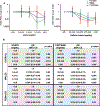Associations of Lower Caffeine Intake and Plasma Urate Levels with Idiopathic Parkinson's Disease in the Harvard Biomarkers Study
- PMID: 32250320
- PMCID: PMC7416447
- DOI: 10.3233/JPD-191882
Associations of Lower Caffeine Intake and Plasma Urate Levels with Idiopathic Parkinson's Disease in the Harvard Biomarkers Study
Abstract
Two purines, caffeine and urate, have been associated with a reduced risk of idiopathic Parkinson's disease (PD) in multiple cohorts and populations. The Harvard Biomarkers Study (HBS) is a longitudinal study designed to accelerate the discovery and validation of molecular diagnostic and progression markers of early-stage PD. To investigate whether these 'reduced risk' factors are associated with PD within this cohort, we conducted a cross-sectional, case-control study in 566 subjects consisting of idiopathic PD patients and healthy controls. Caffeine intake as assessed by a validated questionnaire was significantly lower in idiopathic PD patients compared to healthy controls in males (mean difference -125 mg/day, p < 0.001) but not in females (mean difference -30 mg/day, p = 0.29). A strong inverse association was also observed with plasma urate levels both in males (mean difference -0.46 mg/dL, p = 0.017) and females (mean difference -0.45 mg/dL, p = 0.001). Both analyses stratified for sex and adjusted for age, body mass index, and either urate level or caffeine consumption, respectively. These results highlight the robustness of caffeine intake and urate as factors inversely associated with idiopathic PD.
Keywords: Caffeine; Parkinson’s disease; biomarker; uric acid.
Conflict of interest statement
CONFLICT OF INTEREST
The authors have no conflict of interest to report.
Figures

References
-
- Delamarre A, Meissner WG (2017) Epidemiology, environmental risk factors and genetics of Parkinson’s disease. Presse Med 46(2 Pt 1), 175–181. - PubMed
-
- Marras C, Canning CG, Goldman SM (2019) Environment, lifestyle, and Parkinson’s disease: Implications for prevention in the next decade. Mov Disord 34, 801–811. - PubMed
-
- Ascherio A, Schwarzschild MA (2016) The epidemiology of Parkinson’s disease: Risk factors and prevention. Lancet Neurol 15, 1257–1272. - PubMed
-
- Ding H, Sarokhan AK, Roderick SS, Bakshi R, Maher NE, Ashourian P, Kan CG, Chang S, Santarlasci A, Swords KE, Ravina BM, Hayes MT, Sohur US, Wills AM, Flaherty AW, Unni VK, Hung AY, Selkoe DJ, Schwarzschild MA, Schlossmacher MG, Sudarsky LR, Growdon JH, Ivinson AJ, Hyman BT, Scherzer CR (2011) Association of SNCA with Parkinson: Replication in the Harvard NeuroDiscovery Center Biomarker Study. Mov Disord 26, 2283–2286. - PMC - PubMed
Publication types
MeSH terms
Substances
Grants and funding
LinkOut - more resources
Full Text Sources
Medical

